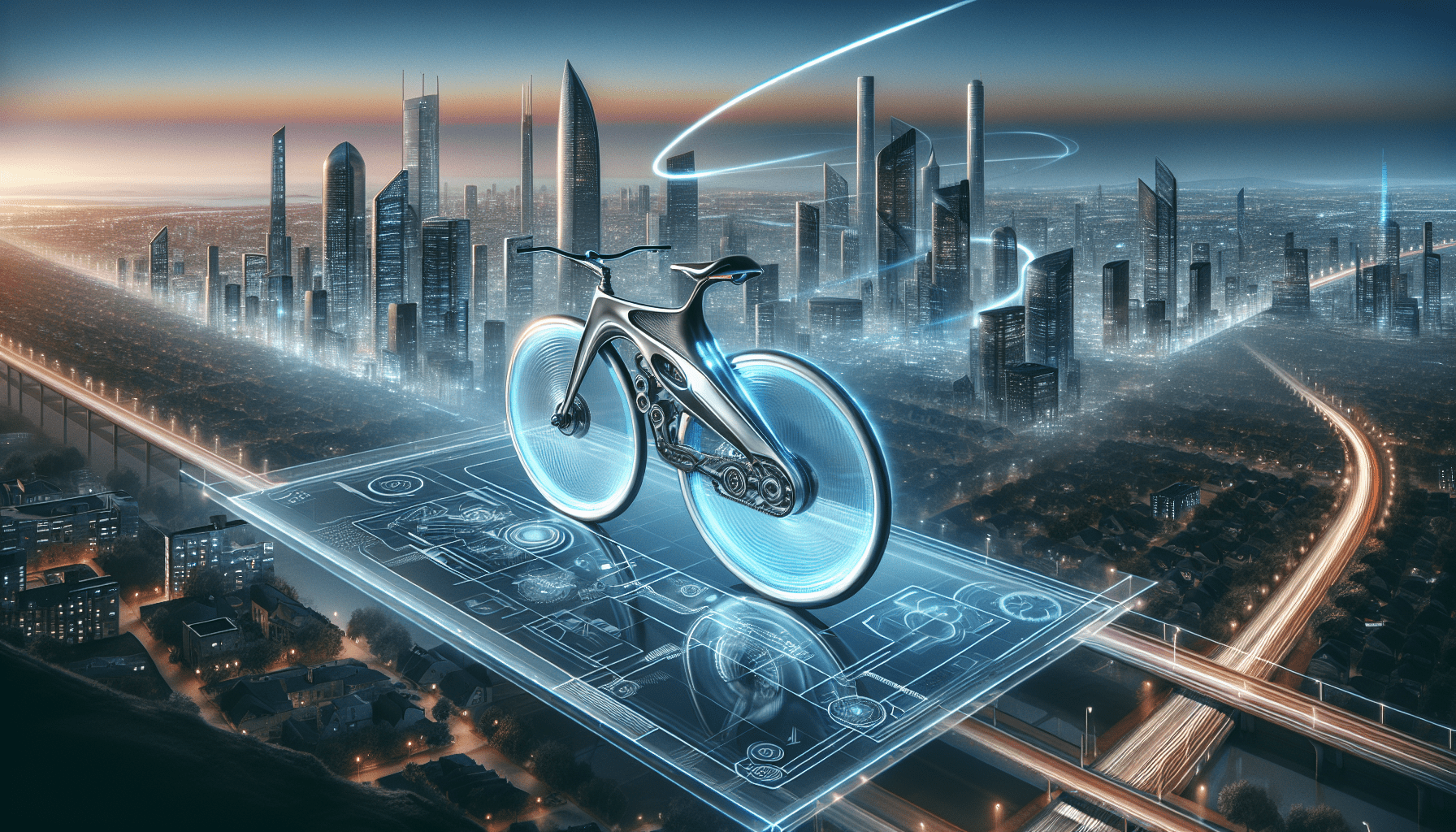What Will Bikes Be Like In The Future?
Imagine a future where biking is more than just a means of transportation, but an entirely immersive and exhilarating experience. Picture sleek, cutting-edge bicycles that seamlessly integrate technology, allowing you to effortlessly glide through city streets and conquer challenging terrains with ease. In this article, we will explore the exciting possibilities that lie ahead for bicycles, envisioning a future where they become not just a mode of transportation, but a gateway to adventure and exploration. Get ready to pedal into the future and discover the incredible advancements that await in the world of biking.

Introduction
In recent years, there has been a growing focus on eco-friendly transportation options as a way to combat climate change and reduce environmental impact. Bicycles, in particular, have gained significant popularity due to their countless benefits. As we look to the future, it is essential to explore the advancements in bicycle technology and their potential to revolutionize urban mobility solutions. From innovative designs and materials to electric power and smart features, the possibilities for the future of bikes are endless.
Current state of bicycles
Currently, bicycles play a vital role in transportation, providing an affordable, efficient, and sustainable means of getting from one place to another. They are not only eco-friendly but also promote physical health and well-being. However, conventional bicycles have limitations, such as the physical effort required for longer distances and uphill climbs. This is where advancements in technology come into play, making bikes more accessible and enjoyable for everyone.
Advancements in technology
Technology has rapidly evolved in recent years, impacting various industries, and the bicycle industry is no exception. Advances in materials, electronics, and connectivity have opened up new possibilities for bicycle design and functionality. From lightweight frames and smart components to electric power and advanced safety features, technology is transforming the way we ride.
Importance of eco-friendly transportation
The importance of eco-friendly transportation cannot be overstated. With the increasing concerns about climate change and air pollution, finding sustainable alternatives to fossil fuel-powered vehicles is crucial. Bicycles offer a solution that allows individuals to reduce their carbon footprint while enjoying the numerous benefits of active transportation. By investing in eco-friendly transportation options like bikes, we can create a cleaner and healthier planet for future generations.
Design and Materials
Innovative frame designs
Innovations in frame design have greatly improved the performance and versatility of bicycles. One example is the use of aerodynamic frames, which reduce air resistance and make riding more efficient. Additionally, folding bikes have gained popularity due to their compactness and ease of storage. Another innovative design is the step-through frame, which allows for easy mounting and dismounting, making it ideal for urban commuting.
Use of lightweight materials
Advancements in materials technology have led to the development of lightweight components that enhance the performance of bicycles. Carbon fiber frames, for instance, offer a remarkable strength-to-weight ratio, resulting in faster and more agile rides. Similarly, lightweight alloys like aluminum and titanium are being widely used to reduce the overall weight of the bike without compromising its strength and durability.
Integration of smart components
The integration of smart components into bicycles is revolutionizing the riding experience. From smart displays and electronic shifting systems to connected sensors and power meters, these technologies provide real-time data and insights to enhance performance and safety. Additionally, smart components can collect valuable information about rider behavior, route preferences, and maintenance needs, enabling riders to optimize their cycling experience.
Electric Power
Electric-assist bicycles
Electric-assist bicycles, also known as e-bikes, have gained significant popularity in recent years. These bicycles are equipped with an electric motor that assists the rider’s pedaling effort, making it easier to conquer hills and ride for longer distances without fatigue. The electric assistance can be adjusted to different levels, allowing riders to choose how much effort they want to exert. E-bikes are an excellent alternative for individuals who want to travel longer distances or who may have physical limitations.
Increased range with advanced batteries
Battery technology has come a long way, and this progress is making electric-powered bikes more practical and efficient. Advanced lithium-ion batteries offer increased range, allowing riders to travel greater distances between charges. Moreover, the development of lightweight and compact batteries has made it possible to integrate them seamlessly into the frame design, ensuring a sleek and balanced aesthetic.
Wireless charging capabilities
Wireless charging capabilities are another exciting development in the world of e-bikes. Instead of the hassle of plugging in the bike to charge, wireless charging allows riders to simply place their bike on a charging pad or dock, eliminating the need for cables and plugs. This convenience makes e-bikes even more user-friendly and encourages more individuals to consider electric-powered transportation.
Smart Features
Connected bike systems
With the advent of the Internet of Things (IoT), bicycles are becoming increasingly connected, transforming them into smart transportation devices. Connected bike systems can provide real-time data on weather conditions, traffic congestion, and even pollution levels, enabling riders to make informed decisions about their routes. Additionally, these systems can integrate with smartphones, allowing riders to control features like lights, navigation, and even lock and unlock the bike remotely.
GPS navigation and tracking
GPS navigation and tracking systems are a game-changer for cyclists, offering the convenience of turn-by-turn directions without the need for a separate device. Integrated into the handlebars or smart displays, GPS navigation provides riders with accurate route guidance, ensuring they arrive at their destination efficiently and safely. Moreover, tracking systems can be invaluable in case of theft, allowing owners to locate their bike and increase the chances of recovery.
Intelligent safety features
Safety is a paramount concern for any cyclist, and technology is playing a significant role in improving rider safety. Intelligent safety features, such as collision detection and blind-spot monitoring, utilize sensors and cameras to alert riders about potential dangers on the road. Additionally, smart lighting systems can automatically adjust the brightness of lights based on ambient conditions, ensuring optimal visibility for both the rider and other road users.

Safety and Visibility
Advanced lighting systems
Lighting plays a vital role in ensuring the safety of cyclists, particularly in low-light conditions. Advanced lighting systems use high-intensity LED lights that are not only brighter but also energy-efficient. These lights provide better visibility for the rider and make the bike more noticeable to other road users, reducing the risk of accidents. Some systems even include adaptive lighting, which adjusts the intensity and beam pattern based on the surrounding environment.
Integrated turn signals
Improving communication between cyclists and other road users is essential for a safer riding experience. Integrated turn signals on bicycles can help indicate the rider’s intentions, just like the turn signals on cars. This feature ensures that other road users are aware of the rider’s intended direction, allowing for smoother and safer interactions on the road.
Enhanced braking technology
Efficient braking is crucial when it comes to safety, especially during emergencies or sudden stops. Enhanced braking technology, such as hydraulic disc brakes, provides greater stopping power and reliable performance in all weather conditions. These high-performance braking systems ensure that riders can stop quickly and safely, giving them peace of mind on their journeys.
Environmental Sustainability
Solar-powered bikes
Harnessing renewable energy sources like solar power is a promising avenue for sustainable transportation. Solar-powered bikes integrate lightweight solar panels into their frames or accessories, allowing the bikes to generate electricity while they are parked or ridden. This solar energy can be used to power integrated lights and smart features, reducing the reliance on traditional energy sources and further decreasing the carbon footprint associated with bike manufacturing and operation.
Reducing carbon footprint
Bicycles already have a significantly lower carbon footprint compared to motor vehicles. By embracing bike transportation, individuals can contribute to reducing carbon emissions, air pollution, and noise pollution. Additionally, the shift towards sustainable materials and manufacturing practices further decreases the environmental impact associated with bike production.
Promoting green infrastructure
The future of biking also lies in creating a supportive infrastructure that caters to the needs of cyclists. Green infrastructure initiatives, such as dedicated bike lanes and bike-sharing programs, encourage more individuals to adopt bicycles as a viable mode of transportation. By investing in these initiatives and integrating them with existing urban plans, cities can create a more sustainable and bike-friendly environment.

Urban Mobility Solutions
Compact folding bikes
In densely populated cities with limited space, the demand for compact and convenient transportation solutions is high. Compact folding bikes offer the perfect solution for urban commuters, as they can be easily folded and stored in tight spaces like apartments, offices, or public transit compartments. These nimble and portable bikes allow commuters to combine biking with other modes of transportation seamlessly.
Shared bike programs
Shared bike programs have gained popularity worldwide as a cost-effective and eco-friendly way to navigate urban areas. These programs provide the convenience of accessing a bike when needed, eliminating the need for ownership and storage. With the integration of smart features like GPS tracking and mobile apps, shared bike programs ensure efficiency in bike allocation and increased user satisfaction.
Integration with public transportation
To further promote a multimodal transportation system, the integration of bikes with public transportation plays a crucial role. By providing seamless connections between buses, trains, and bicycles, individuals can enjoy the benefits of both modes of transportation. This integration allows for longer commute distances, encourages exercise, and reduces reliance on personal vehicles, ultimately alleviating traffic congestion in urban areas.
Future of Bike Sharing
Smart locks and security measures
As bike-sharing programs continue to grow, ensuring the security and availability of bikes becomes paramount. Smart locks equipped with advanced security measures, such as biometric authentication and built-in alarms, can greatly deter theft and enhance user confidence. These locks can be controlled remotely via mobile apps, allowing for easy unlocking and securing of bikes.
Efficient docking and retrieval systems
Efficiency in docking and retrieval is key to the success of bike-sharing programs. Implementing autonomous docking stations or robotic systems that automatically align and secure bikes can significantly streamline the process. These advanced systems ensure that bikes are readily available when needed and make the overall bike-sharing experience smoother for users.
Integration with mobile apps
Mobile apps have become an integral part of our daily lives, and their integration with bike-sharing programs enhances user experience and engagement. Apps can provide real-time bike availability information, maps of docking stations, and convenient payment options. Additionally, integrating features like bike route planning and tracking can further encourage individuals to explore their cities on two wheels.

Health and Wellness
Integrated fitness tracking
With the rise of health-conscious individuals, bikes equipped with integrated fitness tracking offer an excellent opportunity to monitor and improve overall well-being. These systems can track vital health metrics such as heart rate, calories burned, and distance traveled, providing riders with insights into their physical activities. This data can be synchronized with fitness apps or wearable devices, allowing users to set goals and track their progress.
AI-powered coaching
AI-powered coaching is revolutionizing the way we approach fitness and wellness. Bicycles equipped with virtual coaches can provide personalized training plans, offering guidance and motivation tailored to individual needs. These coaches can analyze data from the rider’s fitness tracking system and provide real-time feedback to improve technique, suggest intervals, and make riding more enjoyable.
Comfort-oriented designs
Comfort is an essential factor in encouraging more individuals to embrace cycling as a mode of transportation. Future bike designs will focus on improving rider comfort through ergonomic frame geometry, adjustable components, and vibration-dampening technology. Comfort-oriented designs will ensure that riders can enjoy longer rides without discomfort or fatigue, making biking accessible to a wider range of individuals.
The Rise of E-Bike Deliveries
Efficient last-mile deliveries
The use of e-bikes for last-mile deliveries is gaining popularity in urban areas. E-bikes allow delivery companies to navigate congested streets more efficiently, reducing delivery times and minimizing carbon emissions. The electric assistance enables riders to carry heavier loads and travel longer distances, making e-bikes the ideal solution for quick and environmentally friendly deliveries.
Increased use by delivery companies
Delivery companies are increasingly adopting e-bikes as a cost-effective and sustainable alternative to traditional delivery methods. E-bikes offer advantages such as reduced operating costs, faster delivery times, and less reliance on parking spaces. As the demand for e-commerce continues to grow, e-bike deliveries can revolutionize the logistics industry, providing efficient and environmentally friendly options for same-day and last-mile deliveries.
Reducing traffic congestion
One of the significant challenges in urban areas is traffic congestion caused by delivery vehicles. By utilizing e-bikes for deliveries, companies can significantly reduce the number of vehicles on the road, easing traffic congestion and improving overall traffic flow. The compact nature of e-bikes allows them to navigate narrow streets and park easily, ensuring efficient delivery operations without adding to the congestion problem.
In conclusion, the future of bikes is bright, as technology continues to push the boundaries of what is possible. From innovative designs and materials that enhance performance and comfort to electric power and smart features that revolutionize the riding experience, bicycles are evolving to meet the needs of a changing world. By embracing eco-friendly transportation solutions like bicycles, we can reduce our carbon footprint, promote a healthier lifestyle, and create more sustainable cities for generations to come. The possibilities for the future of bikes are limitless, and the evolution of this timeless mode of transportation is something to look forward to with excitement and anticipation.







